#larval food source
Explore tagged Tumblr posts
Text
From Seed to Sight: A Comprehensive Guide to Growing and Propagating Asclepias Tuberosa for a Lively Butterfly Garden
Brief Overview of Asclepias tuberosa (Butterfly Weed) Asclepias tuberosa, commonly known as butterfly weed, is a captivating, brightly colored perennial plant native to North America. It is a member of the milkweed family, Apocynaceae, and it thrives in a wide range of environments, from open prairies to roadsides. The plant is renowned for its vibrant orange-to-yellow flowers that cluster at…
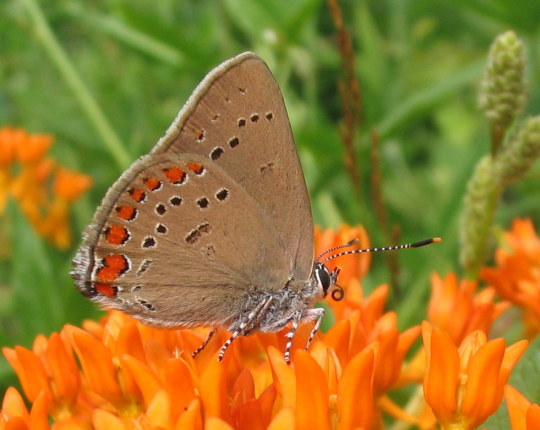
View On WordPress
#Asclepias tuberosa (Butterfly Weed)#attract butterflies#butterflies#butterfly#butterfly garden#drought-tolerant#larval food source#native plant#nectar plant#orange#perennial#yellow
0 notes
Note
Wait, which animals raise livestock?
Several species of ants will 'herd' aphids around (a type of plant lice)- even picking them up and putting them back with the group if they wander off. The ants will attack anything that approaches their aphid herds, defending them. The aphids produce a sugary excretion called honeydew, which the ants harvest and eat.
Some ants will even 'milk' the aphids, stroking the aphids with their antennae, to stimulate them to release honeydew. Some aphids have become 'domesticated' by the ants, and depend entirely on their caretaker ants to milk them.
When the host plant is depleted of resources and dies, the ants will pick up their herd of aphids and carry them to a new plant to feed on - a new 'pasture' if you will.
Some ants continue to care for aphids overwinter, when otherwise they'd die. The ants carry aphid eggs into their own nests, and will even go out of their way to destroy the eggs of aphid-predators, like ladybugs.
--
Microhylids – or narrow-mouthed frogs - have an interesting symbiosis with Tarantulas.
While the spiders could very easily kill and eat the much-tinier frogs, and DO normally prey on small frogs, young spiders instead will use their mouthparts to pick up the microhylid frogs, bring them back to their burrow, and release them unharmed.
The frog benefits from hanging out in/around the burrow of the tarantula, because the tarantula can scare away or eat predators that normally prey on tiny frogs, like snakes, geckos, and mantids. The tarantula gets a babysitter.
Microhylid frogs specialize in eating ants, and ants are one of the major predators of spider eggs. By eating ants, the frogs protect the spider's eggs. The frogs can also lay their eggs in the burrow, and won't be eaten by the spider.
So it's less 'livestock' and more like a housepet - a dog or a cat. You stop coyotes/eagles from hurting your little dog/cat, and in return the dog/cat keeps rats away from your baby.
--
Damselfish grow algae on rocks and corals. They defend these gardens ferociously, and will attack anything that comes too close - even humans. They spend much of their time weeding the gardens, removing unwanted algaes that might overtake their crop.
The species of algae that they cultivate is weak and and sensitive to growing conditions, and can easily be overgrazed by other herbivores. That particular algae tends to grow poorly in areas where damselfish aren't around to protect and farm it.
Damselfish will ALSO actively protect Mysidium integrum (little shrimp-like crustacians) in their reef farms, despite eating other similarly sized invertebrates. The mysids are filter feeders, who feed on zooplankton and free-floating algae, and their waste fertilizes the algae farms. Many types of zooplankton can feed on the algae crop, and the mysids prevent that.
While Mysids can be found around the world, the only place you'll find swarms of Musidium integrum is on the algae farms that Damselfish cultivate.
Damselfish treat the little mysids like some homesteaders treat ducks. Ducks eat snails and other insect pests on our crops, and their poop fertilizes the land. The ducks can be eaten, but aren't often, since they're more useful for their services than their meat.
--
There are SEVERAL species of insect and animal which actively farm. They perform fungiculture and horticulture: deliberately growing and harvesting fungus and plants at a large-scale to feed their population.
Leaf-cutter ants and Termites both chew up plant material and then seed it with a specific type of fungus. The fungus grows, and the termites/ants harvest the mushroom as a food source.
Ambrosia beetles burrow into decaying trees, hollow out little farming rooms, and introduce a specific fungii (the ambrosia fungi), which both adults and larval beetles feed on.
Marsh Periwinkles (a type of snail) cultivates fungus on cordgrass. They wound the plant with their scraping tongue, then defecate into the wound so their preferred fungus will infect it and grow there. They let the fungus grow in the wound a bit, and come back later to eat.
9K notes
·
View notes
Text
Elephant beetle - Megasoma elephas
Here is another info-post, this time on an awesome puppy-sized beetle known as an elephant beetle, or Megasoma elephas.
@hispaatra Researched the puppy beetle :DD


Description
Elephant beetles are black in color and covered with a coat of fine microscopic hairs, in other words their body is hirsute. The hairs grow particularly thick on the beetle's elytra. The hairs give the beetle's body a yellowish colour. Males have two horns protruding from the head and another from the prothorax. The longest head horn gives the beetle its common name, since it resembles an elephant’s trunk. Females have no horns. The horns are used for defense, and in competition among males for food and mates.
In size, elephant beetles typically range between 7 and 12 centimetres. The largest male specimen, that we know of, measures 13.7 centimetres, including the horn.
Diet
For their diet, elephant beetles eat the sap of particular trees and ripened fallen fruits. In captivity, they also eat fruits such as pineapples, longan, lychee fruit, and bark from certain trees like the poinciana.
Breeding
Megasoma elephas larvae develop in large decaying logs or the ground, where the female beetle lays her eggs. Some weeks after that, usually three, the eggs hatch into C-shaped larvae, white grubs with brown heads and six legs. The larval stage lasts around 29 months, during which time the grubs consume organic matter. The third and last stage, the pupal stage, lasts around five weeks at a temperature of 26 degrees Celsius. The life span of an adult elephant beetle is around one to three months.
Distribution and habitat
Elephant beetles can be found in southern Mexico, Central America, and in South American rainforests.
Elephant beetles live in rainforests and are mainly active during the night. They are also able to maintain a high internal body heat when foraging despite reduced ambient temperature.
~~~~~~~~~~~~~~~~~~~~~~~~~~~~~~~~~~~~~~~~~
Image sources:
1.
https://nl.pinterest.com/pin/1477812351560073/
2.
https://nl.pinterest.com/pin/20055160839071562/
~~~~~~~~~~~~~~~~~~~~~~~~~~~~~~~~~~~~~~~~~
Text references:
1.
https://en.wikipedia.org/wiki/Elephant_beetle
2.
https://www.grida.no/resources/1901
3.
https://www.inaturalist.org/taxa/122000-Megasoma-elephas
#hyperfixation#biology#entomology#elephant beetle#Megasoma elephas#beetle#beetles#bugs#insects#bugblr#beloved mutuals#<3
142 notes
·
View notes
Text
Marine biology nerd reacts to Wuthering Waves fishing minigame! Part 1
Hi, I have a BA in biology with an unofficial specialization in marine bio (my college didn't offer anything more specific) so I love everything that has to do with sea critters, and since my enthusiasm about salps got positive reception, I would love to yap about some fun facts relevant to the obtainable fish present in the new fishing minigame in Wuthering Waves 🐟🌊
We're going to start with the...
Fried Egg Jellyfish

The fried egg jellyfish in Wuthering Waves looks like a pretty out-of-pocket design, but fried egg jellies are, in fact, real animals!

Sharing this photo again of one I took near a body of water in my region -- they do legitimately look like fried eggs. 😂 They belong to the genus Phacellophora and are found in most of the world's oceans. (Not to be confused with Cotylorhiza tuberculata, which is also called the "fried egg jellyfish" but is a different species.)
I'm not sure if it varies by region, but where I live, the best time to see them is between mid-July and mid-August, when they appear in droves -- so I see them often enough that I was positively ticked to see them featured in Wuthering Waves essentially unaltered. The caveat would be the note about them purportedly tasting like fried eggs; while some species of jellyfish are indeed edible when prepared properly, I'm not sure about this one specifically, so I can't say I endorse trying -- and even if they are, they probably don't taste like eggs, as jellyfish supposedly bears little to no flavor.
Yarn Eel

I'm going to guess this one is a play on the real animal called the ribbon eel, which is indeed quite colorful, but not necessarily found in large knots. Apparently, while they don't do so well in captivity, they can live for up to twenty years in the wild! (So, depending on who all is reading this... there might be ribbon eels out there that are your age or older. 👀)
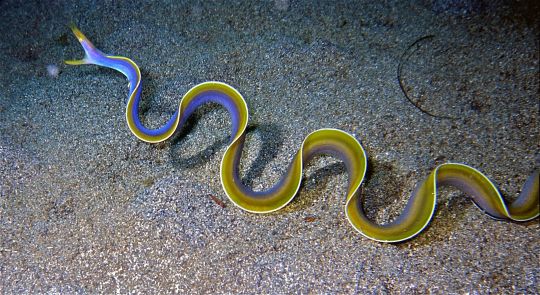
(Image source)
Sob Blob

Many of us might be familiar with the infamous, meme-worthy photo of the "blobfish" on which this critter is quite clearly based. However, did you know that said photograph does not accurately portray what blobfish usually look like?
Blobfish live on the seabed at depths of up to over nine thousand (!!!) feet; to maintain their integrity against the immense pressure at that depth, the blobfish's soft tissues are full of water and fat. So if a blobfish were to get caught in a net and very abruptly moved to sea level, where the pressure is much lower, its "water-logged" tissues effectively explode, giving it the unnatural "blob" appearance featured in the infamous photo.

(Image from NOAA, in the public domain)
This is a real blob sculpin shown in its natural habitat -- and in a much more fish-shaped state! Moreover, unlike the in-game Sob Blob, blobfish don't have a lot of natural predators and can get away with a rather sedentary lifestyle in which they remain largely stationary unless it's absolutely necessary for them to move. Moisturized, unbothered, flourishing.
And, saving probably my favorite featured critter of the bunch for last:
Salp

Salps are much less well-known critters than any of the ones I've described so far, I think! Aside from in Wuthering Waves, I've only ever heard mention of them in the 2007 video game Endless Ocean (of which I was also a huge fan back when I had a Wii). I would say they're not prominent in popular culture by any stretch of the imagination, as far as I'm aware.
Salps are tunicates, a type of marine invertebrate that is nevertheless part of the phylum Chordata that includes all vertebrates, as tunicates possess notochords (the embryonic precursor to the vertebral column), as well as other chordate features, in their larval stage. In this case, the in-game description is at least partially accurate, as salps are a key component of the marine ecosystem and are thought to be a food source for a great many other animals, including fish and seabirds -- though it's difficult to tell exactly which ones, since they're gelatinous and don't leave behind much evidence of being eaten in their predators' digestive tracts. They're also purportedly one of the fastest-growing multicellular animals in the world.
Their life cycle involves an alternation between solitary and "chain" phases depending on the generation. While the salps' in-game entry describes them as sometimes "too small to bother with," IRL the biggest salp colonies can literally grow to lengths of one hundred feet!
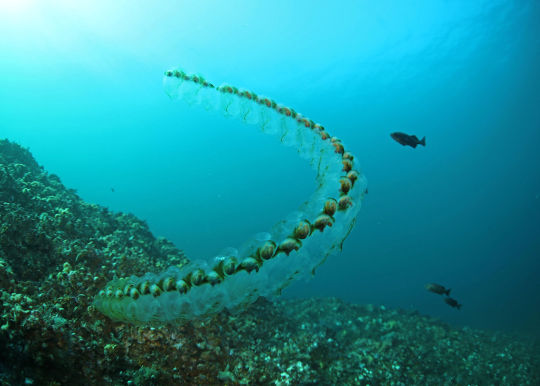
(Image source)
That's about all I have time for today! I've got more critters I can talk about, so be sure to let me know if you're interested in a part two 😉
Part 1 (you are here) -- Part 2 -- Part 3
81 notes
·
View notes
Note
What does the yotici life cycle look like now?
Fairly similar, here's a generalized idea

I Did kind of drop the sessile+asexual polyp mobile+sexual fish alternating generations because it doesn't Really change anything besides sounding vaguely interesting. Fish reproduction is wild enough as-is.
Their eggs are laid in a stringy mass that requires a root to the sea floor (coral, tough kelps, rocks, sticks, etc) and light currents to keep them oxygenated. These egg masses are strong and can bend and sway fairly significantly without coming apart, but will be broken by strong currents and require a sheltered environment to survive. This is the basis of a Garden, an engineered ecosystem designed to protect the eggs, provide substantial and consistent nourishment for the young and resting places and shelter for adults, and additionally function as cultural and social centers.
Larvae are tiny and born with a yolk sac attached to sustain them. They metamorphose into a 'predatory' phase in which they feed on zooplankton and organic debris. These phases are tiny and poor swimmers, wholly reliant on the sheltered environment of the garden for safety and consistent food sources. Those swept out have very little chance of longterm survival. The VAST majority of yotici that hatch at all die in their larval stages.
Most of their anatomy is fully developed as a 'yotling', in which they are much stronger swimmers, school together, and are primarily predatory. Yotlings feed on plankton and other small animals, but their most important food source is their own species' eggs. This is a natural behavior for yotici, and much of the function of the garden is to provide this dependable, clustered food source for their young. The survival benefits of most of their reproductive output being sacrificed to these viable young with a fairly strong chance of survival vastly outweigh the loss, given the vast majority of yotici larvae who hatch to begin with die without ever reaching this phase. Yotlings have much lower mortality rates than the larvae, but a majority will die to predation. They're also frequent bycatch in fisheries and are widely eaten by landdwelling peoples. During the yotling phase, they're about 4-8 inches long.
Their beak starts to develop in the juvenile stage, during which they are 'weaned' out of predatory behavior and start consuming algae and marine plants. They instinctively school around adult yotici and follow them to food sources, usually eating algae that grows around the tougher foods the adults can handle. This tends to be the point in which active parental protection begins, but few yotici cultures conceptualize these juveniles as full people or develop personalized bonds with them, as their mortality rate is still fairly high. During the juvenile phase, they're about 8-14 inches long.
A yotici 'child' has all its base adult anatomy developed, including its tentacles, and looks like a miniature adult. They can eat tougher foods and join the adults in consuming seagrass. This is the point in which they are semi-equivalent to a human infant, rapidly learning and picking up on language and beginning to communicate. Fully active parental care and bonding will occur during this period (the Exact cultural marker of when this starts can vary) and they are conceptualized as people. Diminishingly few yotici actually survive to this phase, but those who do have a very good chance of lasting to adulthood. The child phase starts at about 1-2 ft in length.
At this point they grow steadily until sexual maturity, and will continue to grow (much, much more slowly) throughout the rest of their lives. Sexual maturity takes a VERY long time, usually about 20 years from hatching. An adult yotici generally ranges in size from 12-18 ft, with outstanding or very long lived individuals passing 25 (the World Record would be in the mid 30 ft range). A yotici who survives to reproductive adulthood has excellent chances at a long life, and yotici are by far the longest living sophonts. A lucky individual can crest 200 years.
#Should note that when I make changes for realism it's not because I think worldbuilding should be hyper realistic to be good but because#like. It's fun for me. I like having to think about these things and having to learn and problem solve to conform to Mostly hard#realism. I only drop things when they're not fun for me and/or I like another option better.#And I let a lot of other things be fully unrealistic with like. A little grounding when adjusting for realism would Not be fun for me#Like the three moons is not even slightly realistic (in that it has like no effects whatsoever on this world which is 99.999% earthlike)#but I like it and think it's fun to have the wrinkle of Three Moons and think about how that could affect cultural interpretations of the#moon so I keep it#etc#yotici
123 notes
·
View notes
Text
Wet Beast Wednesday: krill
The ocean is a huge place and food can be sparse. While the ocean receives plenty of energy in the form of sunlight, that energy needs to be converted into a form animals can consume. This is a job that krill have adopted with gusto. These little shrimpy critters live all over the world and play a vital role in the cycling of energy and nutrients. Krill are among the most common and important marine species, but many people overlook them or think of them as nothing but whale food. let's take a dive into the world of krill to show you that there's more there to appreciate.

(Image: a side view of an antarctic krill. It is a shrimp-like animal divided into a solid cephalothorax and flexible abdomen. On one end of the cephalothorax are the eyes and antennae and on the underside are multiple pairs of thin, feathery legs and gills. Along the segmented abdomen are paddle-like appendages. The tail is fanned out. The body is translucent with spots of red pigment. The cephalothorax looks green due to the presence of algae in the stomach. End ID)
There are 86 known species of krill in the order Euphausiacea. While they look a lot like shrimp or prawns, Euphausiacea is actually a sister group to Decapoda, which contains the shrimp, prawns, and most other crustaceans you've heard of. Krill can be distinguished from shrimp by the gills and number and anatomy of the limbs. Krill are zooplankton, a description which makes many people think they must be microscopic. In fact, plankton just means an organism is carried around by currents and cannot swim against them and has nothing to do with size. Most krill reach 1 to 2 centimeters as adults, but some species can get larger. The largest species, Thysanopoda cornuta, can reach 9.5 cm (3.75 in).

(Image: a swarm of krill in the ocean with so many members, it makes the water look red. End ID)
Krill anatomy is very similar to that of shrimp. Their bodies are divided into a cephalothorax, flexible abdomen, and tail fan. The cephalothorax is a fusion of the head (cephalon) and thorax. On the head are compound eyes, mouth, and antennae. Emerging from the thorax are legs. These legs are alternatively called pereiopods thoracopods, or thoracic legs. This is one of the key areas where krill are different from decapods. Decapods always have 5 pairs of thoracic legs and at least some of them are adapted for moving around on the ocean floor. Krill have a varying number of these legs and none are adapted for seafloor life. Krill spend their entire lives in the water column. Behind the legs are the gills, which are exposed to the water. The abdomen is long and flexible and has appendages called pleopods or swimmeretes that are used to assist in swimming and moving water over the gills. Decapods also have these. Finally is the tail fan, which is used in swimming and is also found in decapods. Krill exoskeletons are typically transparent with a bit of pigment on the top. All but one species of krill are bioluminescent, though its possible that the bioluminescence comes from their food. Krill have gills that are exposed to the water while Decapod gills are inside of their exoskeletons.
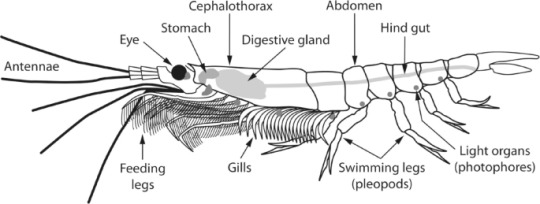
(Image: an anatomical diagram of a krill, with different external and internal body parts labeled. End ID. Source)
Krill are primarily filter-feeders that live in all oceans and in the shallow and deep seas. Most species feed on phytoplankton, especially diatoms, while other are omnivores or carnivores that hunt zooplankton and larval fish. The thoracic legs are covered in filamentous structures and will be held out in a formation called the feeding basket. Plankton passing through the basket will get caught and transferred to the mouth. Krill have a simple digestive tract with a two-chambered gut. The first chamber acts as a mill, crushing the hard shells of the diatoms to make digestion easier. Most krill practice diel vertical migration, a common ocean strategy where animals will remain at depth during the day and move closer to the surface at night. Some species remain in the deep sea all their lives. As krill feed, they become heavier and more sluggish and will sink, allowing the hungrier krill. Krill swim and feed in massive swarms.
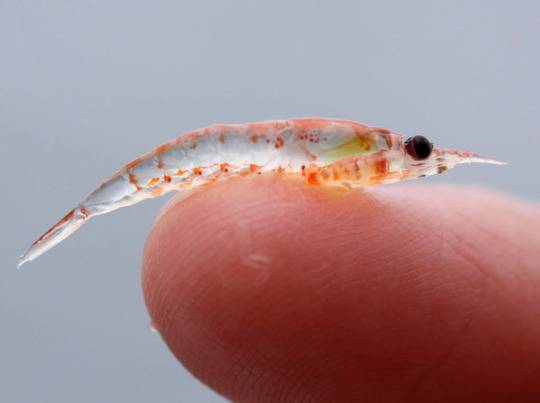
(Image: an antarctic krill balanced on a human finger, to show its size. It is barely longer than the first segment of the finger. End ID)
Krill are a vital part of ocean ecology. Energy is introduced to phytoplankton by the sun and used to produce the energy-storing molecule ATP. Krill eat the phytoplankton and convert that energy into a form larger animals can consume and digest. Whales can't gain energy from phytoplankton, but they can get that energy from krill. Krill are a vital food source for baleen whales, seals and sea lions, fish, squid, and other animals. By eating phytoplankton and then being eaten themselves, krill allow that energy to move through the entire food web. Krill also play a role in moving nutrients and carbon through the ocean. Carbon enters the ocean through runoff and carbon dioxide from the atmosphere entering the surface waters. Phytoplankton take in the carbon dioxide and covert it into forms of carbon that other organisms can use. The krill then eat the plankton, taking the carbon into themselves. Through feces, molted exoskeletons, and dead krill, that carbon can sink into the deep sea, where it can become sequestered in the sea floor. Similarly, nutrients can pass from krill to their predators or into the deep sea through feces and remains. Without krill and other animals filling similar roles, carbon and nutrients would have a much harder time reaching the deep ocean and larger animals wouldn't be able to access the energy stored in phytoplankton.

(Image: a diagram showing the highly complex process by which krill assist in moving carbon through the ocean. End ID. Source)
Being animals with exoskeletons, krill have to molt when they outgrow their current shells. Generally speaking, young krill will molt more often than older ones. Most crustaceans will slow down as they age, with each molt occurring further and further apart. This is not the case with krill, which keep molting at a relatively consistent rate through their lives. some species of krill can also get smaller after a molt instead of always getting bigger. This is used when food is unavailable, reducing the amount of energy the animal needs. Some species have been observed going 9 months between meals. Some species can spontaneously molt as a reaction to threats, leaving behind the empty exoskeleton as a decoy for predators.
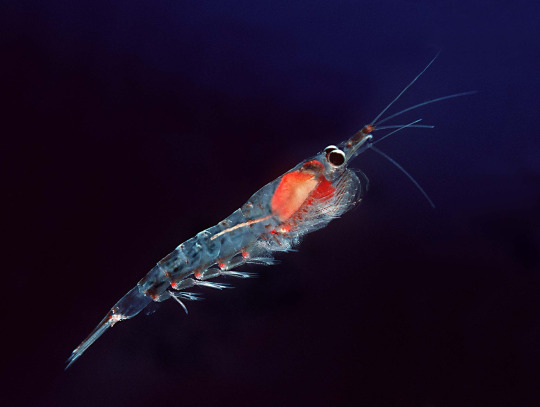
(Image: a northern krill. It is similar to the antarctic krill, but with a different arrangement of pigment. End ID)
Krill typically mate seasonally, though some tropical species can mate year-round. A female can produce thousands of eggs, which can make up a third of her body weight during mating season. Being a major prey animal, krill need to reproduce rapidly to keep their populations up. Most species will mate and produce eggs multiple times per mating season. Males approach females and deposit sacs of sperm into their genital openings. The females then produce eggs which can be treated in two ways. Most species will release their eggs into the water column and provide no further care. 29 species instead attach their eggs to a sac held by the rearmost thoracic legs and carry them until the eggs hatch. Some of these species hatch at a more mature stage. Once the eggs hatch, they have to swim upwards to reach the photic zone of the ocean, where photosynthesis can take place. Larvae progress through several developmental stages. Like other crustaceans, they start as a napulus larva, though some sac-brooders will hatvch at the more advanced pseudometanapulus stage. Either way, they progress then to the metanapulus stage. At this stage, they can lo longer subside on yolk and must reach the photic zone and metamorphose into the calyptosis stage, the first stage with a mouth, before starving. The final larval stage is called the furcilia, which passes through a number of molts. During each molt, the abdomen will grow another segment and pair of swimmeretes. After the final furcilia stage, the krill will resemble a small adult. Krill life spans vary baes on species, from less than a year to 10 years, with species in colder water usually living longer. Relatively few krill will die of old age. In the antarctic krill, Euphausia superba, over half the population is eaten every year.

(Image: several stages of krill development form egg to napulus to more advanced larval stages that look like the adult. End ID. Source)
Krill conservation needs vary by species, but in general, they are highly abundant and in little danger of extinction. Krill are among the most abundant animals in the world, with antarctic krill having one of the largest total biomass of any animal. Monitoring the krill population is extremely important because of their importance to the global ecosystem. Krill have been fished commercially for centuries, used as food, bait, supplements, animal feed, and for shrimp paste and fish oil. Most krill fishing takes place around Antarctica as the krill there are highly abundant and seen as cleaner. As the krill fishery grows, more studies need to be done on the impact on the population and the other species that rely on them. Krill are also impacted by global climate change, ocean acidification, and pollution. Krill can ingest microplastics, which can then be passed onto whatever eats them. Krill are keystone species, meaning they are crucial to the health of their environments. If they go, massive parts of the ocean ecosystem will collapse.

(Image: someone holding a pile of dozens of krill in their hands. End ID)
#wet beast wednesday#biology#ecology#zoology#marine biology#animal facts#invertebrates#invertiblr#crustacean#krill#antarctic krill#informative#educational#image described
127 notes
·
View notes
Text
Round 2 - Chordata - Myxini




(Sources - 1, 2, 3, 4)
The Myxini, commonly called “hagfish”, “slime eels”, or even “snot snakes”, is the most simple class of vertebrates. They have one order, the Myxiniformes, and 3 families.
Hagfish have a cartilaginous skull but no vertebral column, though they do have rudimentary vertebrae. They also have tooth-like structures composed of keratin. Species range from 4 cm (1.6 in) to 127 cm (4 ft 2 in) long. They have elongated, worm-like bodies, and paddle-like tails. The skin is naked and loose, attached only along the center ridge of the back and at the slime glands. They have simple eyespots which only detect light, six or eight barbels around the mouth, and a single nostril. Their jaws move horizontally rather than vertically like other vertebrates, projecting two pairs of horny, comb-shaped tooth plates that grasp food and pull it into the mouth. They are marine predators and/or scavengers.
Hagfish are most well-known for their defense mechanism: releasing copious amounts of slime from specialized mucous glands in their skin. The slime reacts to seawater, expanding to 10,000 times its original size in 0.4 seconds. This slime is flexible, more durable and retentive than the slime excreted by any other animals. If a predator is not deterred by the sudden mouthful of slime, hagfish can also tie themselves into a knot to scrape more slime off of their bodies, wiggling free from their captor while its gills are clogged. Hagfish will also use this traveling knot behavior to clean themselves of any excess mucous.
Very little is known about hagfish reproduction. They are split into males and females, with females usually outnumbering males. Depending on species, females lay from 1 to 30 tough, yolky eggs. The eggs stick together with velcro-like tufts at either end. They do not have a larval stage and hatch as miniature adults.
The oldest-known stem group hagfish are known from the Late Carboniferous, with modern forms first being recorded from the mid-Cretaceous.

Propaganda under the cut:
Hagfish thread keratin, the protein that make up their slime filaments, is under investigation as an alternative to spider silk for use in applications such as body armor.
Hagfish slime threads can also be used as ultra-strong fiber for clothing.
Hagfish skin, used in a variety of clothing accessories, is usually referred to as "eel skin". It produces a particularly durable leather used for wallets and belts.
Remember this?

In 2017, a truck carrying 7,500 pounds of live hagfish got into a road accident on U.S. Highway 101. The aggravated hagfish then released enough slime to cover the road and nearby cars. Horror movie situation tbh.
But why were several tons of hagfish being shipped in a truck? Well, they were on their way to Korea for seafood purposes. Yeah. They are eaten in Korea and Japan.
Hagfish have a sluggish metabolism and can survive months between feedings; this is likely due to the scarcity of food on the seafloor. When food is present, such as a dead whale, they can go into a feeding frenzy.
Here I am listing all these ways that humans use them, but hagfish are also an important part of the deep sea ecosystem. Plus… I think they’re cute and I too wish I could produce a bunch of slime when I don’t want people to touch me. I mean, Howl in “Howl’s Moving Castle” does it and people love him, so…
89 notes
·
View notes
Text










May Beetle Larva - Phyllophaga sp.
When digging in the garden, you just never know what you'll find! In today's showcase, this hardy specimen (and several other insects) was unearthed while I was attempting to untangle the soft bishop's weed roots from the hard, overextending roots of our rambling rose bushes. While the ground cover bishop's weed (sometimes known as ground elder) provides can be effective, it blooms and spreads far too quickly in our garden and it chokes out smaller plants looking to grow. Since it can proliferate very quickly, we have to remove it every few years. It was in the digging and removal of the roots that I found many growing May Beetles. Although they were all beautiful in their own right, the individual seen in these pictures was the largest one found that day. Although not exact due to the curvature of the Beetle Larva's body, its length was measured to be between 4-5cm (closer to 4cm). Judging from its size, this larva was likely near its pupation molting stage, having seemingly grown large in size from all the roots it had around it. As ground-dwelling insects, grubs like this one prefer to keep hidden so that they can dig and drag their way to sources of decaying vegetation or roots.
Those large mandibles in front of their orange head are great tools for carving up plant matter into bite-sized pieces which can be shoveled into their mouths (but they only pinch human skin). Although the individuals I dug up were found beneath rose bushes and bishop's weed, it seems that that this genus also enjoys eating grass roots, so either these grubs are very adaptable, or I may have potentially misidentified this find (doubtful, see end text). In any case, through the consumption of bountiful plant material, robust grubs such as this one grow large until they pupate over time into winged and armored Scarab Beetles. It sounds like a great life and there's a lot to look forward to in adulthood, but there are still dangers to consider. For the biggest examples: a larva that tunnels to the surface too early - especially following rainfall - may become bird food; and skunks can easily find tunneling grubs using their smell and hearing and are eager to gobble them up. In both instances, such a young Beetle would be utterly defense, so they need to smart and remain inconspicuous when tunneling and munching. As these images highlight however, the bodies of this grub are lined with sensory hairs to help keep it safe and warn it of presences near their legs and rear.
Pictures were taken on May 26, 2025 with a Google Pixel 8a. The next post will feature an adult specimen dug up from the same area. Had I not found an adult May Beetle, I would've had to consider that such a find could be the larval form of another Scarab such as the Japanese Beetle. We've had many of those visiting the garden over the years, and that specie loves devouring roses throughout its life cycle. However, the larvae of that Beetle tend to be smaller, their bodies seem to be more grey overall, and their heads may feature a coloration that leans toward reddish.
And of course, all Beetle Grubs were replanted carefully in the soil after photography concluded. However, this Beetle larva will return soon in another post.
#jonny’s insect catalogue#ontario insect#may beetle#scarab beetle#coleoptera#may beetle larva#beetle grub#scarab beetle larva#insect#toronto#may2025#2025#entomology#nature#invertebrates#arthropods#photography#animals
29 notes
·
View notes
Note
Why do the adult stages of insects have short lifespans?
Most animals can't reproduce, and most don't even develop the organ systems to do so, until almost the end of their development. Many mammals are actually rare freaks for their ability to start reproducing as little as a third into their lifespan, and keep reproducing over and over until they die; it's an extreme and radical survival strategy we evolved that comes with some pretty severe trade-offs, in that we have high energy demands and require so, so much food in proportion to most other organisms, not to mention all the ways those reproduction systems can take on illness, malfunction or hurt us. Other animals like birds and reptiles and various fish opted instead to reach adult size as fast as they can, build the reproductive system, and then just take it easy: they live a long time and can mate more than once, but they don't do so constantly and don't make that many young. The MOST common strategy in nature, basically the default norm is to devote most of your life just to eating, growing, and storing resources in your body, then "spend" all the resources you can on reproduction, giving so much of your energy to your babies that it actually kills you. The upside is that this is why most animals make hundreds or even thousands of young in one go, which better guarantees that at least one will survive. Salmon and octopuses are two of the most famous non-insects that do it that way, but so do thousands of other mollusks, fish, members of the various "worm" phyla and others. Many insect groups hyper-streamlined this, so they have a larval stage that's just an eating machine, like caterpillars and maggots, possessing only the bare minimum anatomy they need to keep on eating and growing and nothing else, usually incapable of even traveling from the same food source they were born on. They then use up all of this stored energy to create a body that is perfect for perpetuating their species, including more mobility (such as wings) to spread their population further. Insects exhibit almost every variation there is, but many insect groups hyper-streamlined the basic method so they have a larval stage devoted to non-stop eating, like a caterpillar or a maggot, devoid of any anatomy that does not help it collect all the energy it can as continuously as it can, then use up that energy to build an equally dedicated mating form, which may last only days or weeks because it even gave up the ability to eat as it devoted as much of its body as possible to making those babies in that one big go. There are still many exceptions including insects like cockroaches who mirror the mammal strategy of mating over and over for a relatively "long" adult life, or insects that still only mate the one time, but still at the end of a fairly long adult life that continues to eat and store energy. The most extreme exception to this might be aphids, which continuously develop clone offspring and give live birth to them for their entire life, by which I mean some aphids are born already pregnant with their first clone. These actually still go through a normal mating process too, though, when a winged male finds them near the end of the year, and then they die after laying proper eggs that can survive the winter. The non-stop clone babies are just so that one female has even higher odds of mating with at least one of those males, because now there's 10,000 of her for him to find. To understand basically everything in nature you just have to understand that: 1: life forms actually work like video game characters in that they constantly "farm experience" (nutrient energy) they have to spend on their unique spread of stats and abilities (every body part and system comprising them) 2: every life form evolves as if the only goal of that entire game is to generate offspring and increase the odds of their survival, literally no matter what must be sacrificed.
731 notes
·
View notes
Text
Anatomy practice (1/?): Ephemeroptera
The defining characteristics of this group seem to be 3 pronged tails, two pairs of wings in the adult stage, and two short antenna at the centre of the head.
The larval form lives at the bottom of still water bodies, looking for nutrients. They eat algae, diatoms, and the like. They require clean water to thrive and are a bioindicator of good quality water.
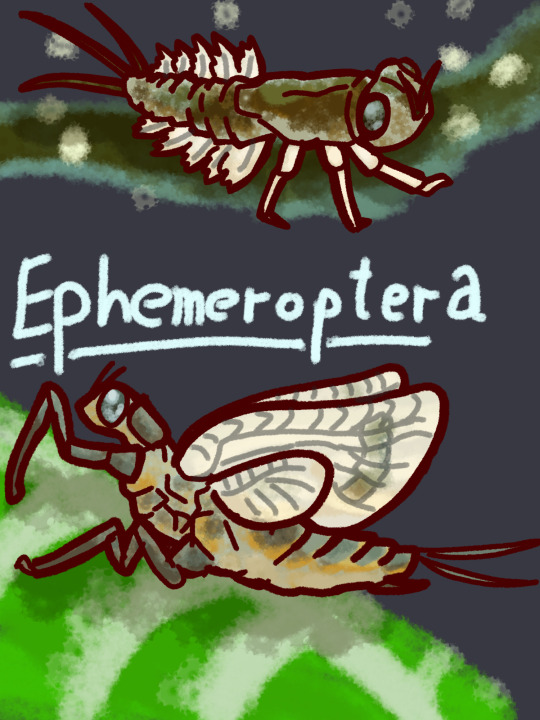
They grow as nymphs through repeated shedding of the whole exoskeleton, until they attain the adult form. This stage is nicknamed the Mayfly as they typically come out in May, but they spend very little time in this form. The adults rarely live longer than a week.
Throughout their life they are a important food source for fish and birds alike.
#art#digital art#medibang paint#coloured art#colored art#Ephemeroptera#Mayfly#Mayflies#invertebrates#Bugs#Bugs on tumblr#Bugblr#entomology#Entomologist#Insects#Insectblr#Bug art#[Cores Crib Sheet]
26 notes
·
View notes
Text


Lepidopterans, the insect clade including butterflies and moths, were among the invertebrate species seeded onto the planet's biome, in order to act as pollinators that allowed the numerous introduced plants to survive. While most of them adhered to this lifestyle and ecological niche, as ravenous leaf-eaters that metamorphosed into flying pollinators, a few began to experiment with more unconventional lifestyles.
Some of the stranger kinds included the caterpedes: a group of neotenic species that matured simply as larger larvae and skip metamorphosis altogether: filling niches as forest floor detritivores, folivores or occasionally even predators of other insects. And perhaps more unusual are the clade known as the Hemimetamorpha, or "half-changed", which do pupate and emerge as adults with proboscises: yet retain their silk glands ejecting silk through a spinneret located directly below the proboscis and between the labial palps, allowing them to construct nests or wrap their eggs in silk sacs for protection.
Many of the Hemimetamorpha do not develop wings, and instead, thanks to their piercing and sucking mouthparts, fill the niches of true bugs on Earth: as sap-suckers akin to aphids, leafhoppers or cicadas, predators of small arthropods, or even as as flea-like parasites on larger animals. And in the case of one clade, the spooders, they use their retained silk glands to spin webs to catch their prey, in a manner akin to their arachnid namesake.
The red-spotted skeeter (Arachnopapilo rubrum) is one widespread Middle Temperocene species, ranging well across the tropics and temperate zones of Gestaltia and Arcuterra. Despite appearances, it sports two ocelli, one next to each compound eye, large feathery antennae possessing olfactory receptors, and a proboscis, albeit a short, sharp one rather than the long, coiled ones of nectar-feeders, all of which mark its lepidopteran ancestry despite the otherwise lack of resemblance to them.
Female red-spotted skeeters spin webs among grasses and branches, waiting to ensnare flying insects that they then immobilize with digestive enzymes in their saliva, while males are smaller and nomadic, instead hunting by pouncing on their prey and traveling across larger areas of territory compared to the more sedentary females who prefer to stay in their webs. They are also more brightly colored, in order to entice a mate, as the larger female is not above preying upon a suitor she does not like, though occasionally, a male may resort to restraining a female with his own silk, immobilizing her long enough to successfully mate and fleeing before she escapes.
Once mated, the female wraps her eggs into a silk pouch, searches out a safe place with plenty of food, and leaves the egg sac there to develop with no further intervention. The young hatch out as fairly typical caterpillars, yet are carnivores like the adults, tracking down and ambushing other small insects, in particular ants due to their foraging trails being a reliable source of food that comes to them as they lie in wait, as well as their toxic compounds being sequestered by the larva for its own defense. With a nutritious protein-rich diet, the larva matures faster than a leaf-eating caterpillar, and is ready to pupate within a week or two, producing a camouflaged chrysalis that is attached to branches and stems and further disguised by bands of silk. After another 5-7 days it emerges as an adult, and is immediately ready to hunt for a meal within minutes, being wingless and thus bypassing the long vulnerable phase of waiting of their wings to unfold. Within the span of a month, another generation is fully-fledged and ready to breed: a rapid turnover vital for a species with high mortality rates and many enemies-- including members of its own species in both their larval and adult forms.
------------
#speculative evolution#speculative biology#speculative zoology#spec evo#hamster's paradise#species profile
55 notes
·
View notes
Text

🌹Rainbow Gerard (and Frank) as a Mother of Pearl Butterfly (Protogoniomorpha parhassus) !
Some facts about these butterflies:
The flight period of adult Mother of Pearl butterflies is year round, peaking in summer and autumn. They have a "ponderous, flapping flight which can be quite fast". The males may perch on the leaves of forest trees, while the females stay closer to the ground near the larval food plants. These butterflies roost under leaves at night, and the males sometimes mud-puddle ! (Source)
#butterfly'd!#butterfly#butterflies#mother of pearl butterfly#mcr#my chemical romance#gerard way#gerard arthur way#frank iero#frank anthony iero#mcr ecosystem#emosystem#m c ars#my chem
12 notes
·
View notes
Text
Moth of the Week
African Wild Silk Moth
Gonometa postica
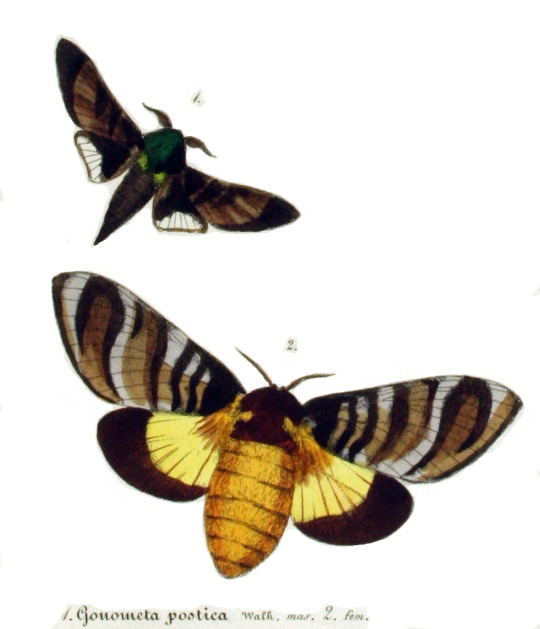
The African wild silk moth is a part of the family Lasiocampidae. It was first described in 1855 by Francis Walker. It is also known as the Brandwurm in its larval stage in Afrikaans, Kweena in its pupal stage in Tshwana, and Molopo moth/mot in English and Afrikaans.
Description The female of this moth is much longer and larger than the male due to having to carry eggs. The male is about half the size of the female and much thinner.
The female has a light brown abdomen with a dark brown thorax and head. The female’s forewings are striped light brown, dark brown, and gray. The hindwings are a yellow-brown with a dark brown edge.
The male has a dark body and wings with a transparent portion of the hindwing.
Female Forewing Range: 35–42 mm (
Male Forewing Range: 21–25 mm (
Diet and Habitat Larva of this species eat Acacia erioloba, A. tortilis, A. melifera, Burkea africana, Brachystegia spp., and Prosopis glandulosa. The larva will feed from the same tree it’s entire life unless there are two many other caterpillars. When there is a large number of caterpillars, they may defoliate the whole tree and the larva must move in order to not starve.
This moth mainly inhabits savannas with many Acacia trees, especially in drier areas. These moths contribute to the Acacia environment by providing food to predators and nutrients to plants through feces. Cocoons are usually found on Acacia tees.
Mating Males detect females’ mating pheromones with their antennae. Males fly to the females because the females are weighed down by the eggs. The female contains about 200 eggs which are laid on the food plant after fertilization. Eggs hatch in about two weeks. Eggs are laid in clumps and the newly hatched caterpillars grow as a group and become more solitary with time.
Predators This moth is preyed on by parasitic wasps and flies. These insects lay their eggs on the caterpillar and feed off of its resources until the moth larva cocoons. The parasites live off the cocoon and grow to adulthood while killing the pupa. Specifically, these larva are subject to parasitism by Diptera and Hymenoptera, the most common parasitoids being Palexorista species from the Tachinidae and Goryphus species from the Ichneumonidae.[6]
To combat external predators and weather, the caterpillars build a tough cocoon. Caterpillars and their cocoons are also covered in stinging hairs to deter predators from touching them. Female cocoons are larger than male cocoons.
Fun Fact In Madagascar, wild silk has been harvested for centuries, and this knowledge has been introduced to southern Africa. The cocoons are harvested commercially in Namibia, Botswana, Kenya and South Africa, and the species also occurs in Zimbabwe and Mozambique. They are difficult to harvest due to the cocoons being covered in calcium oxalate. Oxford University discovered and patented a method known as demineralizing using a warm solution of EDTA (ethylenediaminetetraacetic acid) that soften the cocoons by dissolving the sericin. This lets the silk unravel without weakening it.
- Wild African silk moth cocoons are also used as ankle rattles in southern Africa by San and Bantu tribes. They are filled with materials such as fine gravel, seeds, glass beads, broken sea shells, or pieces of ostrich eggshell.
- Furthermore, the cocoons have long been known to cause the death of cattle, antelope and other ruminants in the Kalahari. During drought periods, the cocoons are eaten, probably because they resemble acacia pods. The silk is indigestible and blocks the rumen of multiple-stomach animals, causing starvation.
- Finally, the protein found in this species’s slik contains many basic amino acids making it a potentially useful biomaterial in cell and tissue culture.
(Source: Wikipedia, SANBI)
#libraryofmoths#animals#bugs#facts#insects#moth#lepidoptera#mothoftheweek#African wild silk moth#Gonometa postica#Lasiocampidae#double post
90 notes
·
View notes
Note
hi! can you talk more about how the yellow mealworm beetle can be used to dispose of plastic and styrofoam? i just think that's so neat :)
I sure can!
Basically, researchers at Stanford University found that mealworms (the larval stage of the YMB) are able to consume and digest polystyrene; specifically styrofoam used for packing and insulation. This means that they're able to break down polystyrene while still being safe to use as a food source for other animals like chickens (Link 1). However, it should be noted that the styrofoam tested contained a toxic substance often used as fire retardant, and the mealworms excreted that substance in their waste. So if mealworms were to be used for large-scale polystyrene disposal, a seperate system would have to be in place for safely removing those toxins from the environment following their excretion. There are also concerns that the excretions contain microplastics-- partially digested plastics that would then be consumed and build up in other animals (link 2).
In short, mealworms provide a promising path for reducing polystyrene pollution, but they aren't a perfect solution yet.
122 notes
·
View notes
Text
Phylum Round 1
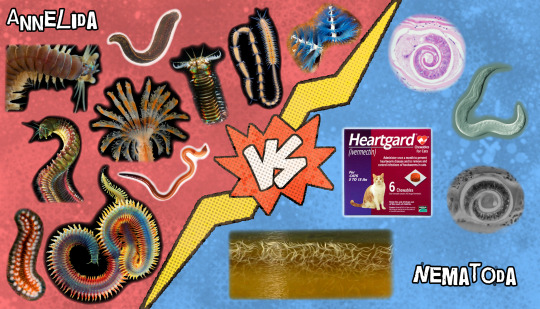
Annelida: Segmented Worms. This group includes earthworms, leeches, and many classes under the umbrella of "polychaete". This diverse phylum encompasses deposit feeders (eating dirt), detritivores, scavengers, deadly ambush predators, filter feeders, parasites, herbivores, and more. They are broadly defined by their repeating body segments and parapodia, which are nubby appendages used for both movement and breathing. Some have curved jaws for catching prey or scraping detritus off of rocks, while others have wide, elaborate feather-like fans for filter feeding. While able to crawl freely, a majority of marine Annelids spend most of their time in self-built tubes or burrows. Among their many important functions, they play a key role in mixing soil/sediment, breaking down decaying organic matter, and providing a key food source to countless other animals.
Nematoda: Roundworms. Split between free-living and parasitic, terrestrial and aquatic, Nematodes inhabit just about every environment on Earth. Nematologist Nathan Cobb once said (paraphrased) that if all matter on Earth disappeared besides Nematodes, we would still be able to identify where everything used to be, simply by the thin layer of nematodes left behind. In the harsh environment of Antarctica's Dry Valleys, these worms dominate the relatively barren ecosystem. The roundworm C. elegans is a widely-studied model organism in science and medicine. Nematodes are also known to parasitize humans, due to their ability to enter a dormant larval state within the muscle of a carrier animal. This is part of why we fully cook pork; to kill any parasites in the meat.
#showing my bias here oops#WORM ON WORM VIOLENCE#sorry y'all I'm literally writing my dissertation on annelid worms <3 come talk to me about bioturbation#and nutrient cycling at the sediment-water interface <3333#nematodes are cool too though! very interesting little guys#cw parasites#annelida#nematoda#animal bracket#tumblr bracket#bracket tournament#poll bracket#phylum round 1#phylum
101 notes
·
View notes
Note
ah, seems like ive come across a new face, huhu..~
alright i'll make it snappy and short. Dont want to be wasting ones time, dont i?
i hand out flowers to people in exchange to know them. And you, luckly little soul have now had the oppurtunity. i present to you, a flower i think adorns thou the most. Nemophila snowstorm. (ooc: lowkey i gen love this flower u can look it up if you want to. Lmao)//
and a spider lily just for good measures. Now my dear friend, my time has seem to run short. We arent living forever arent we? But i must depart. Toodles~!
~✿ (is it sad that this guy is one of my favorite abnos but ive never ever drawn him this is sad.)
Thank you, mysterious florist. I can see why these particular flowers caught your eye.
Did you know that nemophilas serve as the main food source of the larval stage of Erynnis Funeralis? Quite dapper species of butterflies.
It seems quite humorous how I once longed to venture beyond the City, into the Outskirts. To study insects! And that juvenile wish did come true... though, much like the monkey paw it twisted in on itself and came back to haunt me.
I suppose I should be glad I remember more of my past in this former body of mine. So much was lost to me before.
#funeral of the dead butterflies#fotdb rp#ask answered#//I did not know the butterfly larva thing i just found out when looking at the wikipedia page lmao
7 notes
·
View notes